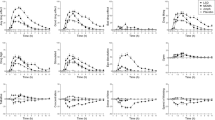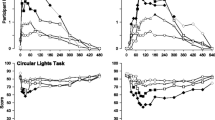Abstract
Two experiments were conducted to assess the acute behavioral effects of triazolam and temazepam in healthy, non-drug abusing men in double-blind, placebocontrolled, crossover trials, where all subjects received all possible doses. These drugs were compared to examine allegations that triazolam produces greater behavioral impairment than temazepam. Drug effect were assessed during 4-h sessions using measures of recall, learning, psychomotor performance, and subject ratings assessing drug effects and abuse potential. In experiment 1, triazolam (0.25 and 0.5 mg/70 kg) produced greater behavioral impairment than temazepam (15 and 30 mg/70 kg). However, triazolam also produced greater increases than temazepam in subject ratings of drug strength, drunkenness and sleepiness, suggesting the dose ranges compared may not have been clinically equivalent. Experiment 2 was conducted to assess whether a higher dose of temazepam than tested in experiment 1 would produce levels of behavioral impairment comparable to those observed with triazolam in experiment 1. In experiment 2, the temazepam dose was increased to 60 mg/70 kg while the triazolam dose was 0.5 mg/70 kg which was the highest dose tested in experiment 1. These doses produced comparable increases in subject ratings of drug strength, drunkenness and sleepiness, but temazepam produced significantly more behavioral disruption than triazolam. These findingsdo not support the position that triazolam produces greater behavioral impairment than temazepam, and may even suggest that across a wide range of doses triazolam isless disruptive than temazepam.
Similar content being viewed by others
References
Bixler EO, Kales A, Brubaker BH, et al. (1987) Adverse reactions to benzodiazepine hypnotics: spontaneous reporting system. Pharmacology 35:286–300
Bixler EO, Kales A, Manfredi RL, et al. (1991) Next-day memory impairment with triazolam use. Lancet 337:827–831
Brahms D (1991) Triazolam suspended. Lancet 338:938
de Wit H, Griffiths RR (1991) Testing the abuse liability of anxiolytic and hypnotic drugs in humans. Drug Alcohol Depend 28:83–111
Dixon, WJ (ed) (1990) BMDP statistical software manual. University of California, Berkely, CA
Duncan DB (1965) A bayesian approach to multiple comparisons. Technometrics 7:171–222
Food and Drug Administration (1992) Psychopharmacological drug advisory committee meeting, May 18, Rockville, MD
Greenblatt DJ, Harmatz JS, Engelhardt N, et al. (1989) Pharmacokinetic determinants of dynamic differences among three benzodiazepine hypnotics. Arch Gen Psychiatry 46:326–332
Haertzen CA (1974) An overview of the Addiction Research Center Inventory: An appendix and manual of scales. DHEW Pub. no. (ADM) 79. Department of Health Education and Welfare, Washington, DC
Halcion 0.5 mg suspended in France (1987a) Scrip 1189:34
Halcion 0.5 mg Italian suspension (F) (1987b) Scrip 1207:27 0.5 mg Halcion withdrawn in FRG (1988) Scrip 1296:3
Higgins ST, Stitzer ML (1990) Comparison of the effects of secobarbital and diazepam on the acquisition of response sequences in humans. Drug Dev Res 20:35–42
Huff JS, Plunkett HG (1989) Anterograde amnesia following triazolam use in two emergency room physicians. J. Emerg Med 7:153–155
Kales A, Manfredi RL, Vgontzas AN, et al. (1991) Rebound insomnia after only brief and intermittent use of rapidly eliminated benzodiazepines. Clin Trials Ther 49:468–476
Kirk T, Roache JD, Griffiths RR (1990) Dose-response evaluation of the amnestic effects of triazolam and pentobarbital in normal subjects. J Clin Psychopharmacol 10:160–167
McLeod DR, Griffiths RR, Bigelow GE, et al. (1982) An automated version of the digit symbol substitution test (DSST). Behav Res Methods Instrument 14:463–466
Morris HH, Estes ML (1987) Traveler's amnesia: transient global amnesia secondary to triazolam. JAMA 258:945–948
Physician's Desk Reference (1992) Medical Economics Company, Oradell, NJ
Rickels, K (1983) Clinical trials of hypnotics. J Clin Psychopharmacol 3:133–139
Roache JD, Griffiths RR (1987a) Lorazepam and meprobamate dose effects in humans: Behavioral effects and abuse liability. J Pharmacol Exp Ther 243:978–988
Roache JD, Griffiths RR (1987b) Interactions of diazepam and caffeine: Behavioral and subjective dose effects in humans. Pharmacol Biochem Behav 26:801–812
Roehrs T, Vogel G, Sterling W, et al. (1990) Dose effects of temazepam in transient insomnia. Drug Res 40:859–862
Rush CR, Higgins ST, Bickel WK, et al. (1993). Acute behavioral effects of triazolam and lorazepam on human learning, performance, and subject ratings. J Pharmacol Exp Ther 264:1218–1226
Scharf MB, Fletcher K, Graham JP (1988) Comparative amnestic effects of benzodiapine hypnotic agents. J Clin Psychiatry 49:134–137
Simenson LLP (1989) Top 200 drugs of 1988. Pharm Times April:40–48
Thorndike EL, Lorge I (1944) The teacher's word book of 30,000 words. Bureau of Publications Teachers College, Columbia University, New York
Triazolam (1988) Inform Pharmaceutiques. OMS 2:32
van der Kroef C (1979) Reactions to triazolam. Lancet ii:526
Walsh JK, Muehlbach MJ, Schwietzer PK (1984) Acute administration of triazolam for daytime sleep of rotating shift workers. Sleep 7:223–229
Williams HL, Geisking C, Lubin A (1966) Some effects of sleep loss on memory. Percept Mot Skill 23:1287–1293
Winer BJ (1971) Statistical principles in experimental design, 2nd Edn. McGraw-Hill, New York
Wysowski DK, Barash D (1991) Adverse behavioral reactions attributed to triazolam in the Food and Drug Administration's spontaneous reporting system. Arch Int Med 151:2003–2008
Author information
Authors and Affiliations
Rights and permissions
About this article
Cite this article
Rush, C.R., Higgins, S.T., Hughes, J.R. et al. A comparison of the acute behavioral effects of triazolam and temazepam in normal volunteers. Psychopharmacology 112, 407–414 (1993). https://doi.org/10.1007/BF02244887
Received:
Revised:
Issue Date:
DOI: https://doi.org/10.1007/BF02244887




